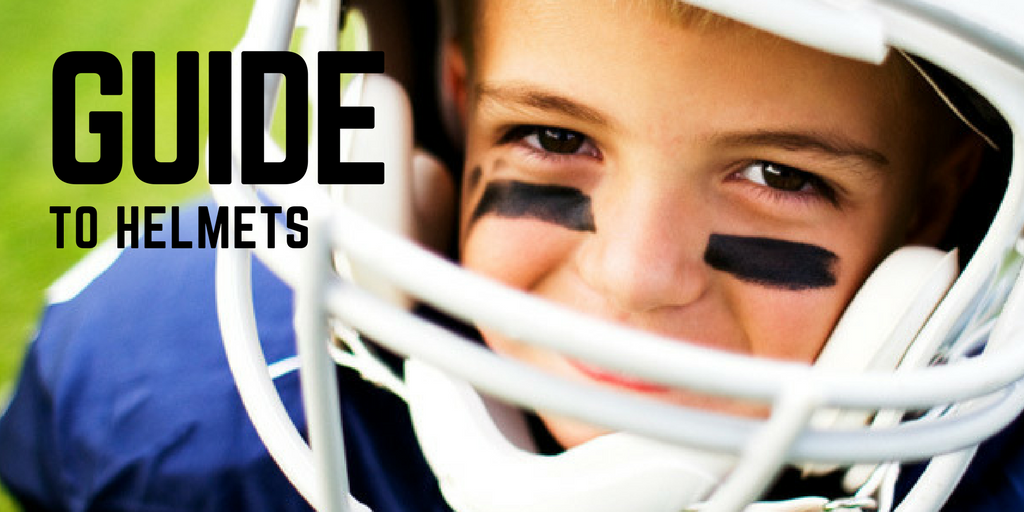Concussion management is a key consideration for many sports and activities, and ensuring that athletes have the right helmet plays a huge part! But why are helmets so important? They are designed to help the head slow down more gradually, spread the impact of a knock or fall over a larger area, and prevent direct impact to the skull. While a helmet won’t completely prevent a concussion or other head injury, it can significantly reduce the impact and the resulting damage. The importance of a good helmet should not go understated, so we’ve put together this Guide to Helmets.
What Size Helmet Should I Buy?
 When you’re ready to buy a new helmet, the right fit ensures maximum protection. Most suppliers will help you pick the right sized helmet once you’re in the store, but you can take care of the measurements yourself ahead of time if you prefer (or to compare)! To do so, take a flexible measuring tape, place it about 1” above your eyebrows, and measure the circumference around your head.
When you’re ready to buy a new helmet, the right fit ensures maximum protection. Most suppliers will help you pick the right sized helmet once you’re in the store, but you can take care of the measurements yourself ahead of time if you prefer (or to compare)! To do so, take a flexible measuring tape, place it about 1” above your eyebrows, and measure the circumference around your head.
Some key things to remember as you and your family are trying helmets on:
- Your helmet shouldn’t move once it’s secured to your head, but it shouldn’t be so tight that it causes discomfort either. A snug fit is key to comfort and safety, so be sure to try on a few and shake your head to test for the best fit.
- Make sure you know how to properly buckle and adjust your chin strap to keep the helmet securely on your head. You should be able to fit your finger between the strap and your chin, but there should be no extra space beyond that.
- Your helmet should sit level on your head (not tilted back on the top of your head or too low on your forehead).
- Help your children put on and fit new helmets. Help them understand the importance of the helmet and to make sure that everything is secure before they start their sport or activity.
When Should I Replace My Helmet?
There are two broad categories of helmets for non-motorized sports, and depending on which type you use, you’ll need to replace it accordingly:
- Single-impact helmets: Designed to absorb the impact of a single serious crash and must be replaced right away (e.g. bicycle and motorcycle helmets)
- Multi-impact helmets: Designed to absorb the impact of multiple crashes and can continue to be used after such impacts (e.g. football and hockey helmets)
Even if you don’t experience a crash or impact, it’s a good idea to regularly inspect your helmet for wear and tear, sunlight exposure, and moisture damage.
You should also replace your helmet every few years, mostly due to UV and sun damage that occurs while you’re wearing it. The general recommendation is to replace a helmet every five years (even if you’ve never had a crash in it). Check the manufacturer suggestions for the optimal time to replace a helmet.
What Are the Different Parts of a Helmet?
 All helmets are constructed with safety in mind, and each part of a helmet has a key job:
All helmets are constructed with safety in mind, and each part of a helmet has a key job:
- The hard, outer shell spreads the force of a crash or a hit over a larger surface area to reduce head injury. It also works to hold all the inner parts of the helmet together, and can provide protection against sharp objects
- The soft, inner liner is made of a thick layer of foam, designed to absorb impact and prevent serious head trauma.
- Some helmets have extra padding or liners for comfort and/or warmth, and can help customize the fit of the helmet to the wearer
- A strong strap should keep the helmet securely on the wearer’s head in the event of impact. These are adjustable and most have a quick-release in case the wearer needs to remove the helmet urgently.
Are There Different Types of Helmets?
Yes! Different activities will call for different types of helmets, as they are designed to protect against impacts that are common to that activity. Choose the helmet that best fits the activities you or your child are participating in, and if necessary, invest in more than one to ensure safety. Parachute Canada and the U.S. Consumer Product Safety Commission have great guides for the exact helmet you need for any type of activity.
As a general rule, always remember that should never use a helmet that isn’t designed for the activity or sport it is being used for. For example, don’t use a bicycle helmet to play football as it will not provide adequate protection for tackles.
Does a Helmet Need to Meet a Specific Standard?
 With more research and learning about the use of helmets, many countries have implemented laws specific to the design of helmets by manufacturers and for the end user.
With more research and learning about the use of helmets, many countries have implemented laws specific to the design of helmets by manufacturers and for the end user.
There are several organizations that set and maintain standards for various helmets, according to the activity they’re designed for. When purchasing a helmet, make sure it’s stamped or labelled with any of the following acronyms (click the links to learn more about each organization):
- ASTM – ASTM International
- CEN – European Commission for Standardization
- DOT – Department of Transportation
- EN – Euro-norm or European Standard
- NOCSAE – National Operating Committee on Standards in Athletic Equipment
- Snell – Snell Memorial Foundation
In addition, in the United States, the Consumer Product Safety Commission (CPSC) is the governing body for making sure that products like helmets meet these safety standards, and in Canada, Health Canada oversees Consumer Product Safety.
Making sure you and your family have the right helmet for any activity is one of the most important parts of being able to enjoy those activities safely. If you have any questions, or would like to share helmet tips and information of your own, please connect with us on Facebook or Twitter!
References:
- Helmets: How they prevent injury (About Kids Health)
- Which Helmet for Which Activity (Helmets.org)
- Eleven Principles for the Best Helmet (Helmets.org)
- Mandatory Bicycle Helmet Laws in Canada (Cycle Helmets)
- Why Should I Replace My Helmet Every Five Years? (Snell Foundation)
Terms and Conditions
All content provided on this blog is for informational purposes only. The owner of this blog makes no representations as to the accuracy or completeness of any information on this site or found by following any link on this site. The owner will not be liable for any errors or omissions in this information nor for the availability of this information. The owner will not be liable for any losses, injuries, or damages from the display or use of this information. This policy is subject to change at anytime.

